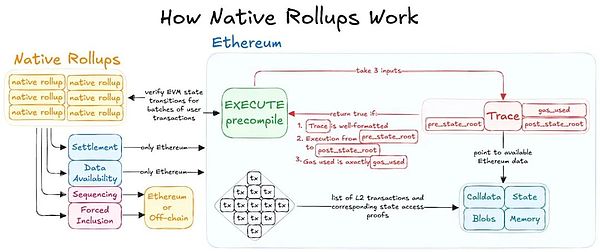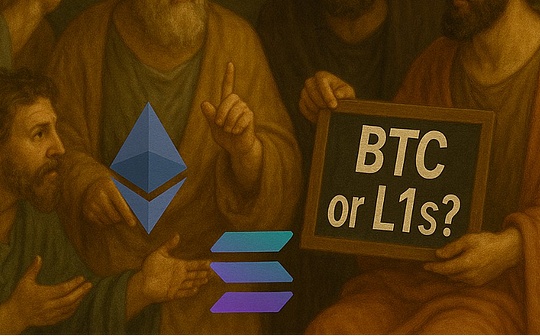
Over the past two years, Ethereum has fully committed to the “Rollup Center” roadmap.This strategy involves locking ETH in a bridge contract, executing transactions off-chain, and using proofs — whether it is fraud proof or zero-knowledge proof (ZKP) — to verify the status of Layer2 (L2) and process withdrawals.
However, there is a major challenge: Ethereum itself does not natively verify EVM execution, forcing rollup to implement its own proof system independently on-chain to verify state transitions.
Ethereum frequently undergoes hard forks, which may modify the EVM, which means that the rollup team must be responsible for maintaining and updating their custom implementations.This usually requires the establishment of a security committee or the adoption of a token-based voting governance system to manage updates to its bridging contracts and proof mechanisms.
In our previous series, we explored the Based rollup and Booster rollup.Now, we will turn to a deeper look at the concept of native rollup.
What is the difference between Based, Booster and Native?
There can be a lot of confusion between the definitions of Based rollup, Booster rollup, and native rollup.In previous series, we’ve covered Based rollup and Booster rollup, so it’s recommended that you check out those before reading this article.But we will quickly review these three types.
Based Rollups uses the L1 validator set for transaction sorting, facilitating decentralization, but may affect throughput due to the relatively long L1 block time (e.g. 12 seconds).However, efforts are being made to improve this experience, using pre-confirmation technology that enables users to enjoy faster final transaction confirmation as the community continues to innovate.
Booster Rollups extends execution and storage by simulating L1 processing on L2, allowing applications to grow without redeployment.Although this approach provides scalability, it introduces additional complexity compared to traditional rollups that require more complex engineering efforts to develop and maintain.
Native Rollups utilizes L1’s own state transfer function (STF) as a validator for applying layer state transitions.However, while Optimism, Arbitrum, and other rollups run in EVM equivalent environments, they usually contain complex or impractical custom modifications that cannot be implemented directly on Ethereum.
Native rollups, once known as legal rollups, have been discussed in detail in various writings.In addition, the term “regulatory rollup” has been@aplynyaUse briefly.However, the term “legal” is eventually replaced by “native” to indicate that existing EVM equivalent rollups may be upgraded to this model.The term “native” is@danrobinsonand an anonymous contributor from Lido.
How does native rollup work?
The native rollup proposal introduces EXECUTE precompilation, designed to act as a validator for rollup state transitions.This precompilation will allow the rollup team to use it in their validator contracts, provide based on the proof system, and enable rollup to inherit native verification from Ethereum.
Since this new precompilation is somewhat similar to the concept of “EVM in EVM”, it will be updated under its social consensus through Ethereum’s hard forking process.This ensures that changes to EVM are reflected in precompilation, enabling rollups to inherit Ethereum’s verification and alleviate the governance responsibilities of the rollup team in terms of security committees or multi-signatures, thus making rollups more inherently secure to users.
EXECUTE is precompiled as a validator for EVM state transitions, allowing rollup to utilize Ethereum’s native based facilities at the application layer.It uses inputs such as pre_state_root, post_state_root, trace, and gas_used to verify the conversion, using gas pricing mechanisms similar to EIP-1559.Depending on the scalability requirements of rollup, validators can enforce the correctness of rollup state transitions by re-execution or SNARK proof.In addition, slot-by-slot delays are integrated to mitigate centralized risks such as MEV-based proof competition.
This precompilation simplifies rollup development with “trustless rollup” support in the proof system.If combined with the Based rollup design, where the sorting and proofing system are managed by Ethereum, this structure enables complete trustlessness, often referred to as “ultrasound rollup”.It improves composability and has the potential to settle in real time, thereby encouraging more composability and security rollup designs.

The proposed precompilation behaves similarly to EVM, re-executing the rollup transaction to verify correctness.This is contrary to the core advantage of rollup, because rollup’s advantage lies in off-chain execution, and only submits proof of validity to Ethereum.Instead, precompiling essentially reflects what Ethereum has done and does not add any value in reducing the compute burden from L1.
Choosing an EVM-like validator instead of a zk validator stems from the current immaturity of ZK technology.The widely used zkVMs have shown vulnerability, and the rapid evolution of ZKP makes hard-coded specific zk validators on chain risky and inflexible.Ethereum instead prioritizes diversity and neutrality, allowing experimentation on different zk clients without locking onto a single validator.
However, this does not mean that precompilation fails to contribute to the scalability of Ethereum.Although Ethereum ensures its security by keeping the zk proof validator off-chain, it utilizes this precompilation to verify the zk proof submitted by rollup.This allows Ethereum validators to avoid fully emulating all rollup transactions from start to finish.Instead, by relying on off-chain zk proofs, the network maintains its security assurance while working to achieve scalability in terms of execution.
What are the main advantages of native rollup?
With native rollup, many complex tasks can be processed by precompilation, making fraud proof or SNARK checking, etc. easier.This means less code needs to be written and maintained without additional systems like proof networking or security committees.
On-chain SNARK verification is expensive, so many zk-rollups do not frequently settle transactions in order to save costs.EXECUTE precompilation can help reduce these costs by recursively packing multiple proofs together using SNARK.This approach allows rollup to validate transactions more efficiently, thus making off-chain verification more cost-effective.
Ensuring error-free operations in traditional rollups is a challenge and often requires extensive checking.Many teams reduce risks by adopting centralized sorting to prevent the creation of malicious blocks.However, a more secure and permissionless sorting mechanism may be implemented through precompiled native execution.This approach allows rollup to inherit not only the security of L1, but also the substitutability of assets, because transactions are directly verified in Ethereum’s trust environment.
There are many EVM-compatible rollups, but few are equivalent to EVM: Keeping changes in sync with the main blockchain usually requires a team or voting system to update rollups, which can pose risks.Native rollups can be automatically updated with the main blockchain, keeping everything in sync without additional rules or voters.
For zk-rollups, achieving proof times with ultra-low latency, such as 100 milliseconds, is a highly challenging engineering task.By contrast, native rollups may allow for a more “loose” proof schedule that extends it to a full slot.This approach relieves the pressure to generate proofs immediately, possibly improving reliability and enhancing integration with L1.
Will all rollups be native?
Currently, all rollup stacks, such as OP Stack and Arbitrum Orbit Stack, have the potential to transform into “native rollups” and directly inherit the security features of Ethereum.This upgrade will make users more satisfied as security is enhanced and the rollup team feels more comfortable because they no longer need a safety committee.Meanwhile, the rollup team can still continue to compete by providing an efficient shared sorting layer and capture sorting fees to maximize MEV.
However, not all rollups will transition to native forms.Some L2 features are inherently incompatible with native rollups, including unique transaction types, different gas accounting methods, and precompilations that are not found on the main L1 blockchain.The diversity of VMs among L2 rollups, each sharing a common security based, is a major advantage of today’s L2 ecosystem, for example
@EclipseFNDIt’s SVM rollup,
@movementlabsxyz
is MoveVM rollup, or@StarknetIt is CairoVM rollup.
Just as@doganeth_enAs noted, future rollups will be divided into three categories: enterprise rollups, performance-oriented rollups, and “aligned” native rollups.
Businesses will focus on managing, sorting and owning their rollups, ideal for businesses that want to enjoy web2-like control over transaction order, execution and applications.
Performance-focused rollups will use Ethereum’s settlement, but rely on alternative data availability for optimal performance, e.g.
@megaeth_labsuse@eigen_da
to achieve data availability.These rollups have a lower degree of decentralization, but improve
$ETH
, but at the expense of certain Ethereum features.
Native rollups will be fully integrated with Ethereum’s Based facilities and provide: Ethereum-level decentralization, shared execution with direct state access, and cheaper off-chain ZK proof verification.These rollups contribute to Ethereum’s network effects, which may share revenue, but their sustainability depends on natural economic incentives.
in conclusion
Native rollups represent a significant advance in the Ethereum rollup central roadmap, providing a way to align more with the Ethereum-based facility.By introducing EXECUTE precompilation, native rollups simplify governance, eliminating dependency on multi-signatures, security committees, or token-based voting systems.This approach not only enhances security, but also enables rollups to scale more efficiently, leveraging off-chain zk proofs, ensuring trust minimization and scalability.
Although the proposal has broad prospects, it is not without its challenges.Although most existing rollups are labeled as EVM equivalents, they usually have minor modifications to EVM.Therefore, transitioning to a native rollup model may put additional development burden on rollups with customized EVM implementations.
Native rollups provide a compelling path to combine Ethereum’s security and flexibility with rollup design.By promoting alignment with L1, they encourage innovation while reducing fragmentation, making Ethereum’s ecosystem closer and resilient in the future.If you haven’t viewed it, be sure to view it
Part OneandPart 2The Rollups 2.0 series focuses on Based Rollups and Enhanced Rollups respectively.In our next post, we will dive into the concept of gigagas rollups and explore how this innovative rollup design can drive the scalability boundaries of Ethereum and further enhance the rollup ecosystem.
Acknowledgements: This article is from@paramonowwwrite.Special thanks@korayakpinarrfeedback and review.







